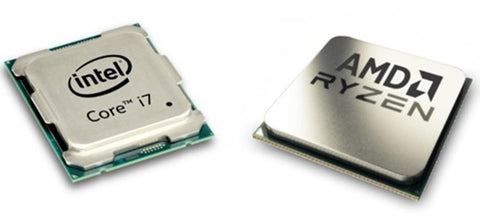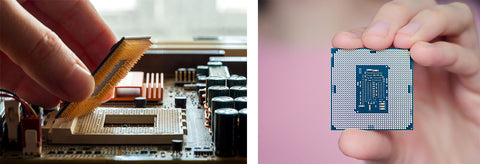What is a CPU?
The CPU, an abbreviation for central processing unit, is essentially the brains of a computer where most calculations occur. It fetches data from memory, carries out instructions, and executes logical or arithmetic operations on data. The faster it can process data, the more expensive it is. And although there are various names to describe CPUs, like microprocessors or computer processors, just recognize that they are referring to the same thing.
Many of the devices we use daily, from browsing the web on our phones to running video games on our computers, have a CPU. While CPUs are a core element of computers systems, they are a small part of a motherboard-based architecture that separates components based on function, then connects them together through a central interfacing circuit board. There must be a memory drive to hold data, audio chip to decode and amplify music, and a graphics processor to render images and videos. And as of 2018, most of the laptops and smartphones sold are based on the x86 architecture.
X86 Architecture and its importance in micro processing
One of the most dominant processor-based architecture in the semiconductor industry, the x86 architecture, developed by Intel Corporations in 1978 , is the backbone of multiple microprocessors used today. It serves as a logical framework that defines how processors handle and execute different instructions provided through an operating system, acting as a family of instruction set architecture (ISA).
What makes the x86 architecture stand out is its software and applications backwards compatibility, efficient manufacturing, and legacy support. Because software costs dominate hardware costs, building software from scratch is very costly. And the x86s support for additions and extensions to be included to the x86 instruction set, all while maintaining compatibility with previous generations, makes it an optimal choice for cost-efficient manufacturing.
Other major competing CPU manufactures, like Advanced Micro Devices (AMD), have also adopted the x86 for its dominant performance. The AMD Athlon and Intel Core are some of the most popular x86 processors to date. While the Athlon series was discontinued in 2005, the Intel Core processor brand was brought into market in 2006 with continued support through new generations, still actively supported in the roadmap today. While it’s rare that ‘aged’ technology can last multiple decades, it does happen. And in this case, Intel and AMD just can’t seem to retire the x86 due to many market segments requiring a foundation of x86 computing platforms to support vertical like – laptops, personal computers, compute-intensive workstations, and high performance servers.

Intel and AMD CPU Comparison
What is a socket CPU?
The CPU socket is a single connector on the motherboard that provides a mechanical connection and electrical interface with the CPU. This allows for relatively smooth upgrades and replacements of CPUs, with the only drawback being the increased thickness and weight.
The socket is a distinctly shaped mount strictly for the CPU chip that ensures correct chip insertion and prevents damage when moving unit. Most modern CPU sockets are based on either a pin grid array (PGA), with square pins arranged on the underside of the package, or a land grid array (LGA), with pins on the socket. While the LGA runs a lower risk of damaging the fragile pins when inserting the chip into a socket, the PGA architecture makes it easier to straighten out the pins if bent. Either way, there is no definitive answer about which CPU socket type is better.

Pin Grid Array and land Grid Array
These days most CPUs include multiple processing cores, which can be utilized in a socket CPU design. These cores act as individual processors, allowing for multiple systems to run simultaneously without unnecessary latency. Socket CPUs have the ability to add additional cores onto a single die allowing it to run multiple complex processes at the same time, but also speeding up your system and increasing its overall performance. The cores can send commands to a dedicated PCH for further specialization of external functions such as the PCIE and USB ports. While current SoC have an integrated PCH and lacks the necessary architecture to hold multiple cores.
Thermal Design Power (TDP) and its importance in industrial computers
Socket CPUs run at higher performances, meaning they usually have a higher thermal design power (TDP). A higher TDP requires some additional cooling through a heat-sink dispersed with a fan since higher thermal temperatures may cause systems failure and throttle down their speed and potentially jeopardizing important applications.
One key benefit from Premio industrial computers is its fanless design with an LGA socket CPU that uses passive cooling through heat dissipation. The robust aluminum finned chassis acts as a heat-sink to dissipate heat but also transfer detrimental heat away from the critical components like the CPU. By leveraging the multi-core performance from a socket CPU and integrating a fanless passive cooling design, computing deployments in rugged environments are able to provide performance and mission critical reliability.
What is a System-on-chip (SoC)?
A systems-on-chip (SoC) is an integrated circuit that combines all components of a computer into a single substrate system. Along with a CPU, its components include advanced peripherals like a graphics processor (GPU) and memory storage (RAM and ROM). While socket CPU have a choice between PGA or LGA architecture, SoC typically feature a ball grid array (BGA). This is a process where balls of solder are applied on the pads of CPU and physically melted to contact points on the motherboard, a process that occurs during the PCBA part of the PCB manufacturing process. This design is common in mobile computing (smartphones) and rugged industrial computers to reduce power, weight and size.
Because SoC integrates hardware and software, it requires less space and uses less power. The compact system integration of rugged industrial computers offers better reliability and functionality, with various applications in IoT gateways and edge computing. Mobile computing also utilizes on-chip caches for their wireless network capabilities and digital camera hardware for real-time computational power.

Picture sourced by Embedded Computing Design
Premio Industrial Computers with both SoC and Socket Options:
Up until now we have been primarily discussing the fundamental differences between a socket and SoC desktop designs. In addition, there is also another expertise of socket and SoC embedded computing designs that are more rugged and specialized, geared towards specific workloads in industrial applications.
Embedded socket CPUs operate at a higher temperature threshold and offer higher performance with more cores; whereas an embedded SoC uses considerably less power but with understandably less computing power. The efficient and optimal size of SoC designs offer greater flexibility for industrial applications and IoT deployments that require low-power computing performance. Premio offers both types of designs as options for our industrial computers to allow for greater flexibility and scalability between embedded chips or full-sized socket CPUs. Learn more about all our embedded industrial computers here.




